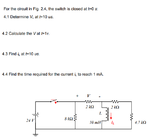cartman007
Member level 2
Hi Everyone.
I have what seems to be an easy LR circuit problem I would like to have some input.

Is it safe to assume that because first 2K-Ohm resistor is actually in parallel with the 8K-Ohm resistor since the inductor at 0 is a short?
Also will the 2K+4.7K = 6.7K also be in parallel with the inductor and the rest of the resistors?
Example:

OR will the 6.7K-ohm just be omitted?

I have what seems to be an easy LR circuit problem I would like to have some input.

Is it safe to assume that because first 2K-Ohm resistor is actually in parallel with the 8K-Ohm resistor since the inductor at 0 is a short?
Also will the 2K+4.7K = 6.7K also be in parallel with the inductor and the rest of the resistors?
Example:

OR will the 6.7K-ohm just be omitted?

Last edited: